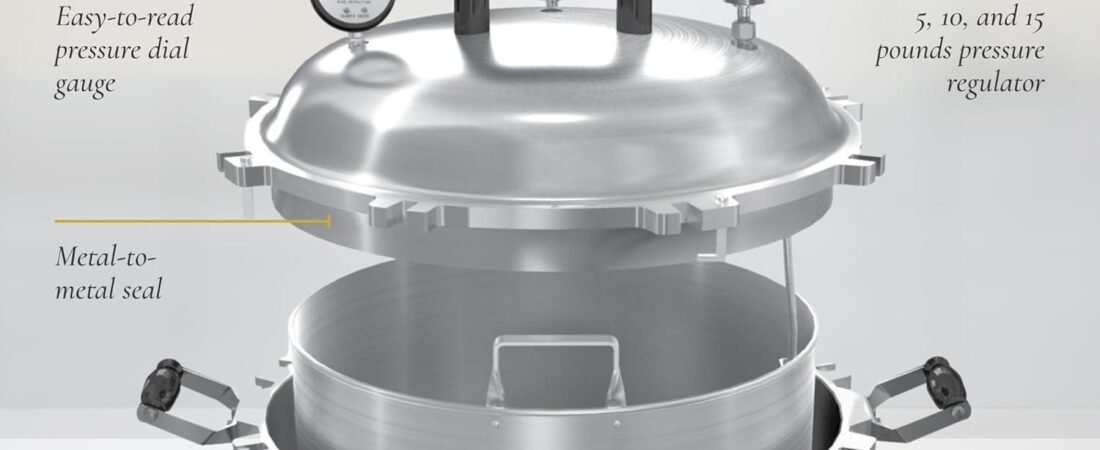Extensive Review of All American 1930 Sterilizers
Introduction
All American 1930 is known for manufacturing high-quality, durable, and efficient sterilizers that cater to a variety of needs, including medical, laboratory, and home environments. Their sterilizers are designed with superior craftsmanship, using high-grade materials to ensure safety, longevity, and performance. In this extensive review, we will cover the different models of All American sterilizers, their features, specifications, and uses in various industries, including mushroom farming, tattoo parlors, research laboratories, medical applications, and homesteading.
Models and Features
1. 50X Electric Sterilizer (25 Quart Capacity)
The 50X Electric Sterilizer is a complete, self-contained unit with features that make it an excellent choice for professionals and home users alike. Some of its key characteristics include:
- Immersion Heating Element: The built-in heating element ensures quick and efficient steam generation.
- Automatic Thermostatic Control: Maintains a consistent temperature throughout the sterilization process.
- Automatic Release Valve: Ensures safe operation by regulating pressure.
- Pilot Light Indicator: Provides a visual cue when the sterilizer is in operation.
- Metal-to-Metal Seal: Eliminates the need for gaskets, ensuring an airtight seal.
- Hand-Cast Aluminum Construction: Offers even heat distribution, corrosion resistance, and exceptional durability.
- Stay-Cool Bakelite Handle: Enhances safety by reducing heat transfer.
- Included Sterilization Rack: Helps organize items during the sterilization process.
- Standard Electrical Compatibility: Operates on regular household outlets, making it accessible for most users.
This model is particularly useful in small clinics, research labs, and even home-based businesses where a reliable and compact sterilizer is required.
2. 75X Electric Sterilizer (41 Quart Capacity)
The 75X model shares many of the features of the 50X but offers a larger 41-quart capacity. This additional space is perfect for environments requiring higher volume sterilization, such as:
- Hospitals and Clinics: Sterilizing surgical tools and medical instruments.
- Dental Offices: Cleaning and sterilizing reusable dental equipment.
- Tattoo Shops: Ensuring all tools are properly disinfected before use.
- Large-Scale Mushroom Cultivation: Pasteurizing and sterilizing substrate bags efficiently.
With its larger capacity, the 75X Electric Sterilizer is an excellent option for users who need a reliable, high-volume sterilization solution.
3. 1925X Non-Electric Sterilizer (25 Quart Capacity)
For users who require a sterilizer that doesn’t rely on electricity, the 1925X model provides a versatile solution. Its features include:
- Compatible with Any Effective Heat Source: Can be used with gas, propane, or wood stoves, making it ideal for off-grid locations.
- Heavy-Duty Cast Aluminum Construction: Ensures durability and resistance to wear and tear.
- Inner Container with Rack: Keeps items organized and optimally placed for steam penetration.
- Low Water Requirement: Generates steam efficiently with minimal water usage.
This model is especially beneficial for homesteaders, remote clinics, and survivalists who need a reliable sterilization method without relying on electricity.
4. 1941X Non-Electric Sterilizer (41 Quart Capacity)
The 1941X is the larger version of the 1925X, featuring a 41-quart capacity for users who require more space. Like the 1925X, it is compatible with alternative heat sources and is built to last. Its primary uses include:
- Rural Medical Clinics: Ensuring safe sterilization in areas with limited electricity.
- Veterinary Practices: Sterilizing surgical instruments and equipment.
- Mushroom Cultivation: Large-scale sterilization of growing substrates.
With its robust design and high capacity, the 1941X is one of the best options for those looking for a reliable, non-electric sterilization solution.
Applications and Uses
1. Mushroom Cultivation
All American sterilizers have become extremely popular in the mushroom-growing community. Sterilization is a crucial step in mushroom cultivation as it prevents contamination by harmful bacteria and mold. The key applications in mushroom farming include:
- Sterilizing Grain Spawn: Ensuring that grain spawn (such as rye or wild bird seed) is free from contaminants.
- Sterilizing Substrate Bags: Preventing contamination in sawdust or other growing mediums.
- Maintaining Clean Workspaces: Disinfecting tools used in the inoculation and fruiting process.
Electric models like the 75X are ideal for commercial mushroom growers who require high-volume sterilization, while non-electric models like the 1941X are great for off-grid or mobile growing operations.
2. Medical and Laboratory Use
Medical professionals and researchers rely on All American sterilizers for decontaminating instruments, glassware, and other sensitive equipment. Their key applications include:
- Sterilizing Surgical Tools: Preventing infections in hospitals and clinics.
- Disinfecting Dental Equipment: Ensuring safe and reusable dental tools.
- Research Laboratories: Maintaining a sterile environment for microbiology and chemistry experiments.
With their precise temperature controls and durable construction, these sterilizers are a trusted choice in the healthcare and research sectors.
3. Tattoo and Piercing Studios
In the tattoo and body modification industry, sterilization is critical for preventing infections. All American sterilizers are commonly used to:
- Sterilize Needles and Tubes: Ensuring all equipment is free of harmful bacteria and viruses.
- Disinfect Jewelry and Instruments: Keeping piercing tools sterile for each client.
The 50X and 75X models are particularly favored by tattoo artists due to their compact design and ease of use.
4. Veterinary Practices
Veterinarians require sterilized tools for surgery and other medical procedures. All American sterilizers help in:
- Sterilizing Surgical Instruments: Ensuring safety during animal surgeries.
- Disinfecting Dental and Grooming Tools: Maintaining hygiene in animal care.
- Sterilizing Wound Dressings: Keeping bandages free from contaminants.
5. Homesteading and Survival Preparation
For those who live off the grid or prepare for emergencies, having a reliable sterilization method is essential. Non-electric models like the 1925X and 1941X allow homesteaders to:
- Sterilize Canning Equipment: Preventing food spoilage in home preservation.
- Disinfect Medical Supplies: Ensuring first aid tools are clean and ready for use.
- Prepare Drinking Water: Using sterilizers to purify water in emergency situations.
Conclusion
All American 1930 sterilizers are an industry standard for those requiring a robust, efficient, and reliable sterilization method. With electric and non-electric models ranging from 25 to 41 quarts, there is an option for nearly every application, from home users to professional settings.
Whether you are a medical professional, researcher, tattoo artist, mushroom cultivator, veterinarian, or homesteader, an All American sterilizer can provide the durability and performance needed to ensure the highest levels of safety and hygiene. Their hand-cast aluminum construction, metal-to-metal sealing system, and precision engineering make them an excellent investment for anyone in need of a high-quality sterilizer.
Proudly made in the USA, these sterilizers exemplify American craftsmanship and innovation, making them a trusted choice for professionals and enthusiasts alike.
Comprehensive Guide to Using All American 1930 Sterilizers
Safety Precautions
Before operating any All American 1930 sterilizer, observe these essential safety measures:
- Always inspect the unit for damage before use, particularly the metal-to-metal seal
- Ensure proper ventilation in the operating area
- Never operate the sterilizer without adequate water
- Use heat-resistant gloves when handling hot surfaces
- Keep children and untrained personnel away from the unit during operation
- For electric models, verify proper grounding and cord condition
- Never attempt to open the sterilizer while under pressure
Pre-Operation Checklist
- Clean the sterilizer thoroughly before each use
- Check the metal-to-metal sealing surfaces for debris or damage
- Verify all controls and safety valves are functioning
- Ensure proper water level according to model specifications
- Arrange items on the rack to allow proper steam circulation
Operating Instructions
For Electric Models (50X and 75X)
- Initial Setup:
- Place the sterilizer on a level, heat-resistant surface
- Fill with the specified amount of distilled water
- Position the rack in the bottom of the chamber
- Arrange instruments with adequate spacing
- Loading:
- Wrap instruments in appropriate sterilization materials
- Place heavier items at the bottom
- Avoid overcrowding to ensure proper steam circulation
- Leave space between packages
- Operation:
- Secure the lid by tightening wing nuts in a star pattern
- Plug into a properly grounded outlet
- Set the thermostat to the desired temperature
- Wait for the pilot light to indicate heating
- Monitor pressure gauge during operation
- Allow full sterilization cycle (typically 15-30 minutes at 250°F/15 PSI)
- Cooling and Unloading:
- Allow pressure to return to zero naturally
- Wait for unit to cool before opening
- Remove items using sterile technique
For Non-Electric Models (1925X and 1941X)
- Heat Source Setup:
- Position the sterilizer on an appropriate heat source
- Ensure stability and level placement
- Add specified amount of water
- Loading:
- Follow same loading principles as electric models
- Ensure instruments are properly wrapped
- Use internal rack for proper positioning
- Operation:
- Apply heat gradually
- Monitor pressure gauge
- Maintain consistent heat source
- Time sterilization cycle from when proper pressure is reached
- Cooling:
- Remove from heat source after cycle completion
- Allow natural pressure reduction
- Cool completely before opening
Maintenance Guidelines
Daily Maintenance:
- Clean and dry the chamber after each use
- Inspect sealing surfaces
- Check pressure gauge and safety valve operation
- Wipe external surfaces
Weekly Maintenance:
- Deep clean all components
- Verify control functionality
- Check electrical connections (electric models)
- Lubricate wing nuts if needed
Monthly Maintenance:
- Conduct thorough safety valve testing
- Inspect heating elements (electric models)
- Check accuracy of pressure gauge
- Verify thermostat operation
Troubleshooting
Common Issues and Solutions:
- Pressure Not Building:
- Check water level
- Verify lid seal
- Inspect safety valve
- Check heat source/power connection
- Steam Leaks:
- Clean sealing surfaces
- Check wing nut tightness
- Inspect for damage
- Verify proper assembly
- Uneven Heating:
- Check heat source
- Verify proper water level
- Ensure level placement
- Check heating element (electric models)
- Safety Valve Release:
- Reduce heat/temperature
- Check pressure gauge accuracy
- Verify proper operation
- Clean valve if necessary
Emergency Procedures
- In Case of Power Failure (Electric Models):
- Turn off power
- Allow natural cooling
- Do not attempt to open until pressure normalized
- Excessive Pressure:
- Reduce heat immediately
- Ensure safety valve operation
- Monitor pressure gauge
- Prepare for emergency shutdown if necessary
- Steam Leaks:
- Turn off heat source
- Allow cooling if safe
- Evacuate area if significant
- Document incident
Specifications and Operating Parameters
Model-Specific Guidelines:
50X Electric (25 Quart):
- Water Capacity: 2.5 quarts
- Operating Pressure: 15-17 PSI
- Temperature Range: 240-250°F
- Heating Time: 12-15 minutes
- Cool-down Time: 25-30 minutes
75X Electric (41 Quart):
- Water Capacity: 4 quarts
- Operating Pressure: 15-17 PSI
- Temperature Range: 240-250°F
- Heating Time: 15-20 minutes
- Cool-down Time: 35-40 minutes
1925X Non-Electric (25 Quart):
- Water Capacity: 2.5 quarts
- Operating Pressure: 15-17 PSI
- Temperature Range: 240-250°F
- Heating Time: Varies by heat source
- Cool-down Time: 25-30 minutes
1941X Non-Electric (41 Quart):
- Water Capacity: 4 quarts
- Operating Pressure: 15-17 PSI
- Temperature Range: 240-250°F
- Heating Time: Varies by heat source
- Cool-down Time: 35-40 minutes
Record Keeping
Maintain detailed records of:
- Each sterilization cycle
- Maintenance performed
- Any issues or incidents
- Temperature and pressure readings
- Duration of cycles
- Items sterilized
- Operator information
Warranty and Support
Contact All American 1930 for:
- Technical support
- Replacement parts
- Warranty claims
- Training resources
- Documentation
- Maintenance guidance





